5 Top daily sales report fmcg salesmen send is road to successful future
Today and now, increasing sales productivity is one of the fastest ways to increase sales.
In fact, 79% of sales executives say a leading driver of hitting new targets is improving the productivity of sales reps.
Therefore, high productivity is a necessity for any sales team looking to boost sales.
In this comprehensive guide, you’ll find:
- Easy and effective ways to increase your sales team’s productivity
- Shortcuts to sales success
- Tips to achieving your sales career goals faster
- Expert advice on how to keep a winning mentality in sales
- A bonus hack to boost your productivity
A daily sales report can help you gain insights, pointing out bottlenecks and gaps in your sales process. It helps your sales team understand the challenges that lie ahead of them and find solutions in time.
But all said and done, we have to agree that generating sales reports can be a mundane activity and is not directly related to selling. So, it is natural for your sales team to not want to invest too much time in it.

What is a Daily Sales Report?
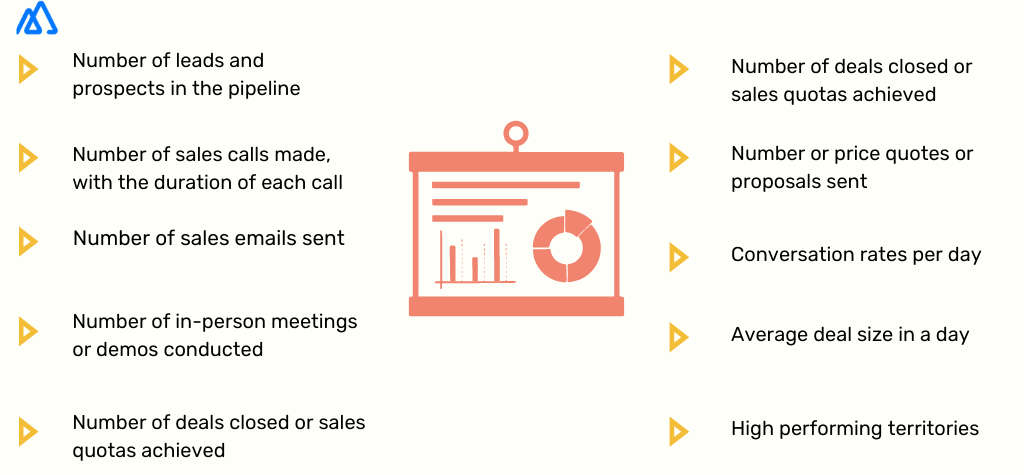
A daily sales report is a sales tool that summarizes all the sales activities taking place in a business during the day.
It reports about what your sales reps have done on a working day, including the number of calls made, emails sent, in-person meetings attended, deals closed, and so on.
According to a survey 81% of sales teams felt that infrequent audits of their sales process were their biggest setback. In such a case, a daily sales report is found to be much more useful and effective than a monthly or yearly report.
It provides continuous updates to the management and offers valuable insights into the company’s sales activities more frequently and in a more detailed manner. It could contain the name of the sales rep, the clients being handled by them, the number of calls/ emails they have executed during the day, etc.
But for a more comprehensive report, you would need to add some more valuable information. This is usually sales performance data that compares the daily sales activities with the sales objectives. Such reports can be created by the sales manager or by the sales reps themselves.
Benefits of Creating a Daily Sales Report
Although generating a sales report daily may seem time-consuming, it has several benefits for your business that you can’t overlook. Some of the key benefits you enjoy when your business has access to a daily sales report are the following.
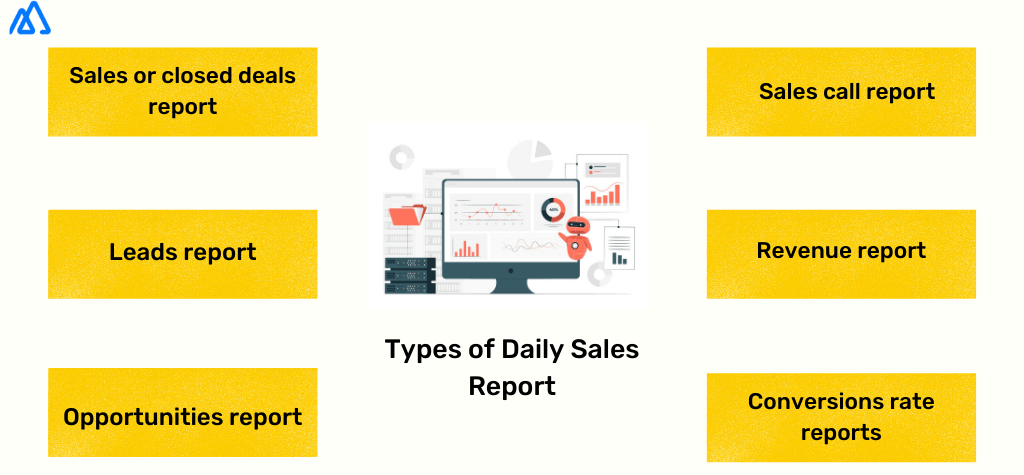
1. Helps Optimize the Sales Funnel
Not all leads that your sales team generates are worth nurturing. But they won’t know that unless there is a visible trend. According to statistics, 60% of sales reps waste their time pursuing poor leads. This only lengthens tracking follow ups for them and makes pushing these leads through very difficult.
Having this reporting system in place would help you identify which leads must be prioritized and which can be ignored. For instance, leads coming from certain channels are known to convert, from your business’s historical data.
Or certain prospect behaviours indicate that the prospect will take longer than usual to decide. You can ask your sales personnel to prioritize and deprioritize leads on these bases.
This helps optimize your sales funnel and shorten the sales cycle.
2. Assists in Decision-making
Making the right decisions at the right time is crucial in sales. When you receive regular updates on your sales processes and activities, you are in a better position to make well-informed decisions.
For instance, you can see which products are generating more revenue every day. So the decision on the focused products for your sales reps becomes a lot easier to make.
A daily sales report will help you determine the sales volumes, cash flow, future trends, and more. All of this can help you make better decisions for the future of your sales. Though monthly sales reports may provide you with the same information, they cannot show you in-depth data on each sale as a daily sales report can.
Daily reports make it easier to track performances, identify patterns, detect problems and take timely action.
3. Motivates and Boosts the Confidence of Salespeople
The daily sales report is also important for your sales team’s morale. Daily monitoring of each salesperson’s performance motivates them to achieve more. It gives rise to healthy competition within the team, which in turn increases the productivity of the team members.
They also boost the confidence of your team members. When their sales actions are backed by data and insights, they are more confident about handling prospects and winning deals.
4. Brings a Sense of Accountability
A monthly report or an annual report does not show you much about what an individual salesperson has been doing. But with a daily sales report, each individual’s activities and performance can be monitored. This also brings an overall sense of accountability among the team members.
A sales manager will be able to tell who is responsible for nurturing a particular prospect. Or know who is responsible for answering a customer’s queries. With such consistent monitoring, every salesperson is bound to be responsible and answerable for their actions.
What Should Be Reported in Your Daily Sales Report?
The daily sales report can vary for each organization based on its unique sales objectives. But certain data are common to all sales teams, irrespective of what you are selling. Some of the common data points that every daily sales report should cover, include –

These are just a few of the key points to cover, you can have more data points depending on your daily sales goals.
Types of Daily Sales Reports
When we talk about daily sales reports, we don’t necessarily mean there has to be just one report. You can create a number of different sales reports for your business every day. In fact, creating various reports for different areas of sales will give you much deeper customer insights than a single consolidated report.

How do you write a good sales report?
Here are some commonly used daily sales report types you can create for your business.
1. Sales or Closed Deals Report
This report is required to show you the number of deals closed or transactions completed on a given day. This kind of report works best for retailers or consumer goods businesses that usually make a few sales daily.
For B2B sales, it may not be possible to attain daily sales data. The sales cycle here is longer and buyers take more time to make a purchase decision.
But for businesses that cater to individual end-users, a daily sales report on completed transactions can be useful. You can ascertain the cash flow and profits earned, from this report.
2. Leads Report
A comprehensive daily sales report on the number of new leads generated in a day is also imperative to business. This report gives you an idea of how many leads are in your pipeline and how many of these are qualified leads.
This information can tell you if your sales reps are spending time on low-quality leads. You can help them prioritize based on the new leads’ eligibility.
3. Opportunities Report
This report can show data on the number of prospects contacted in a day and how many of these conversations ended positively. If your sales reps have been able to schedule a meeting or demo or convince the prospect to move to the next step, it is a sales opportunity created.
4. Sales Call Report

This daily sales report captures all the details on the sales calls made by each sales rep in a day. It includes the number of calls made, the duration of each call, the outcome of each call, and so on.
The sales call report can give you an idea of how many deals your team is able to close daily overcall, which territories are responding better to their sales calls, etc.
Insights from the sales call report can tell you which of your sales and cold calling strategies are working and help you sort your call list better.
5. Revenue Report
The daily revenue report tells you how much revenue has been generated by your sales team in a day. You can create revenue by salesperson report to better understand the contribution of individual team members to the revenue.
The revenue by salesperson report can contain the daily quota, daily sales goal, number of deals closed, number of deals lost, and percentage contribution to total revenue for each salesperson.
It gives you a good view of individual team members’ performances.
6. Conversion Rates Reports
This is by far one of the most important reports for any sales team. Conversion rate, as we are already familiar with, is the ability of the sales team to convert leads into prospects and prospects into customers. But again, this can be a daily sales report for retailers and businesses selling low-priced consumer products.
For B2B sales or high value-added products, it is not viable to calculate conversion rates daily. They would gain more from monthly or quarterly conversion rate reports instead.
A high conversion rate in your daily report will tell you that the strategies you are currently using are delivering results. Similarly, a lower conversion rate would mean your sales strategies need improvement.
Creating a daily sales report on your conversion rate will allow you to address issues on time so they don’t roll over into the next month or next quarter.
How to Improve Your Daily Sales Reports?
Creating a daily sales report can be easily automated if you have the tools for it. But even for automated reports, you have to decide what insights you would like to see and how these should add value to your business.
To help you pick the right KPIs, monitor sales performance better, and create more insightful reports, here are a few tips.
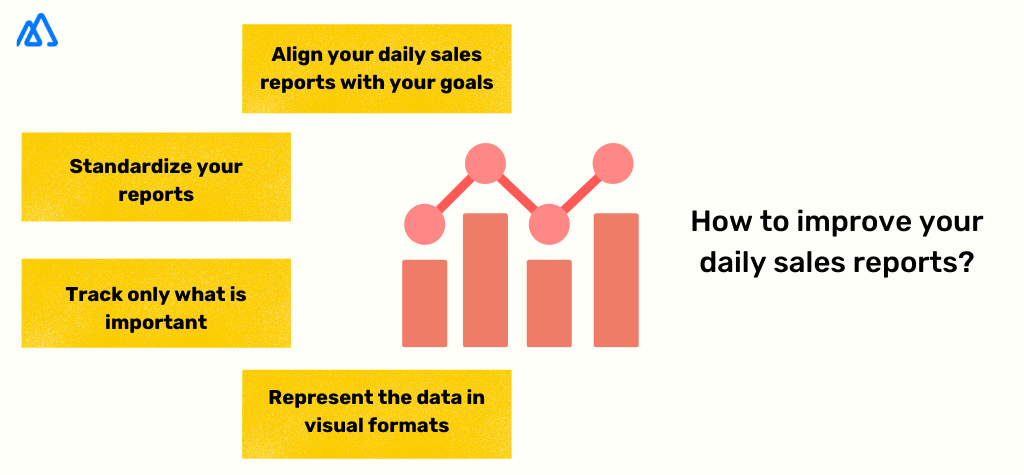
How to improve your daily sales reports
1. Align Your Daily Sales Reports With Your Goals
The ultimate aim of analysis and reporting is to help you achieve your goals faster. With a daily sales report, you are trying to evaluate and audit your sales process every day so that your sales goals are attained.
To make sure these reports are useful, you must be clear about your goals for the sales team.
You must be sure about what it is that you are trying to measure and what questions the report should answer.
2. Standardize Your Reports
For reports to be easily comprehensible, standardization of the data and metrics presented is important. Make sure that whoever is creating the daily sales report follows these standards.
3. Track Only What Is Important
To keep your reports relevant and meaningful, you need to focus only on the metrics and KPIs that matter to the sales process and your goals.
Tracking too many metrics will only make your reports more complex and harder to understand. Such reports may take up a lot of your sales team’s time and still not deliver any useful insights.
4. Represent the Data in Visual Formats
Reading and drawing conclusions from data is a lot easier when it is presented in a visual format. Data visualization is seen as increasingly important in all business areas and sales is no different.
A 2013 survey revealed 86% of managers in organizations using visual data discovery tools are more likely to find timely information compared to only 67% who don’t use visual data.
Harvard Business Review found that new hires who had a one-on-one meeting with their manager in the first week experienced early growth. They also spent 2x more time collaborating with their teammates than those who did not have a one-on-one.
The next step is to set milestone-based goals with 30, 60, and 90-day plans. For example, an effective 30-day plan would be focused on learning about the products, the buyers, and the market.
Then, schedule check-ins to discuss their progress. Having open communication channels with your reps is really important to understand their concerns, needs, and pain points.
2. Utilize Sales Tools to Step Up Your Game
Did you know that high-performing sales teams use nearly 3x the amount of sales technology than underperforming teams?
Finding the right sales tools will make your management easier by improving your team’s productivity and efficiency in every aspect.
Every successful sales manager and their sales team can benefit from:
- CRM tools that facilitate better tracking of sales activity
- Prospecting tools that quickly identify promising leads
- Communication tools to interact with customers and teammates
- Route optimization apps to keep track of field activity and optimize sales territories
- Sales intelligence tools for data-based decisions and optimized sales processes

Here are some examples of the top sales software in different categories:
Internal Communication
Slack simplifies communication. It creates a shared workspace where your sales team can exchange ideas and documents. It’s also a fun space where your team can celebrate any win.
Communication with Prospects
Intercom makes it simple to message and track prospects.
Intercom’s Inbox helps organize and respond to conversations on your website, through social channels, or via email. It creates meaningful ways to interact with your prospects and customers.
Route Optimization & Territory Management
There’s no better route planner for field sales
Route planner does more than just route optimization with 100+ stops. It’s equipped with territory visualization, check-ins, on-the-go lead generation, and more.
Route planner helps field salespeople save time planning, improve relationships with customers, and close more deals. On average, salespeople using Badger spend 20% less time driving and sell 22% more.
3. Focus on The Right Sales Goals
Every sales team has different goals, but guess what?
Only 43% of sales professionals achieved their sales goals in 2019, and 2020 was even worse!
In most cases, the reason why sales teams miss their goals is not that goals are too hard, but they are unrealistic.
In business, resources are limited. Distributing your energy across too many projects can only damage your sales productivity.
However, if you can focus on a shortlist of high-quality sales goals, you will be more motivated to achieve them, develop better sales strategies, and hit your target faster.

Here are a few criteria of a high-quality goal:
- Specific result — Focus on optimizing one or just a few key metrics.
Bad goal: To minimize costs now.
Better goal: To lower customer acquisition costs in future.
- Measurable result — The progress can be measured.
Bad goal: Receive a good rating on G2.
Better goal: To increase our G2 rating to 4.8 out of 5.0.
- Target date — Set a deadline for achieving the goal.
Bad goal: To increase the number of leads qualified per month by 18%.
Batter goal: To increase the number of leads qualified per month by 18% by year-end 2021.
- Realistic — Salespeople perform at a higher level when they work toward realistic goals.
- Team-set — Sales teams who set their own goals as a group generally outperform those who have their goals assigned by their manager.
4. Automate your Sales Process to Save Time and Money
How many repetitive tasks are your reps doing every day?
On average, sales reps spend 21% of their time writing emails.
The more unproductive tasks your reps have, the less time they have left to sell. To increase sales, you can automate most parts of your sales processes.
Automated triggered emails, or emails that prospects will automatically receive based on their actions, played a huge role in this astonishing growth.
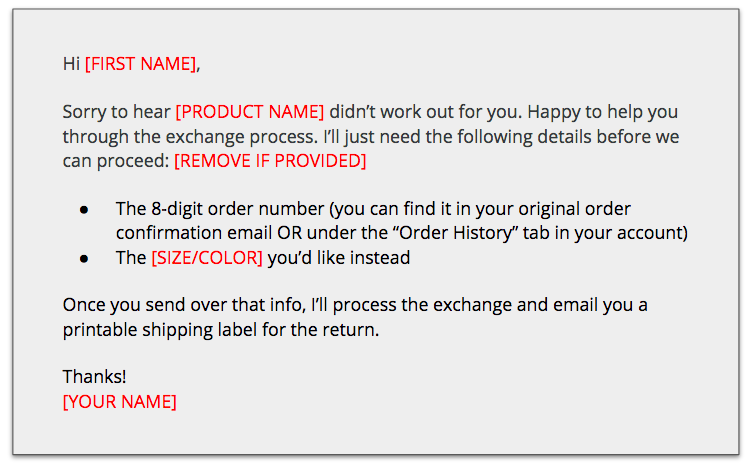
(Source: Business 2 Community)
To get automate your email sequences, analyze your reps’ daily tasks and understand:
- What are the most common emails sent daily?
- Which of those are repetitive?
- To what extent each email should be personalized?
Common automated emails include:
- Welcome emails
- Lead nurturing emails
- Follow-ups
- Objection handling emails
- New customer emails
- Upsell emails
- Thank you emails
Notice a pattern here?
Yes, these are all parts of the sales cycle. Start by creating automated email campaigns on email automation platforms and you will see an instant boost in the productivity of your sales team.
Using chatbots is another way to automate some parts of your sales process.
Chatbots can save time to the sales team by qualifying website visitors, allowing them to schedule meetings, answering some product questions, and more — just like a human would, but with reduced costs.

Route optimization is another type of automation that can help you save time and costs to increase sales.
Finding the optimal route for multiple stops is a complex calculation, because of factors such as distance, traffic, number of turns, etc. That’s when you need route optimization software that uses computer algorithms to quickly compare all different scenarios and find the fastest route.
5. Keep Your Team Motivated to Reach Their Full Potential
When employees are motivated to work, they will put their best effort into their tasks.
Companies that motivate their employees regularly see a 50% increase in sales and 38% above-average productivity.
Here are some strategies you can follow to keep your team motivated:
Praise in Public
Public recognition is an easy way to boost employee motivationand engagement. Everybody likes being appreciated in front of others for specific contributions to the team.
You can host a regular meeting celebrating both big milestones and small achievements. In the meeting, recognize all the goals your team has achieved since the last appreciation meeting, then select a few high performers.
When praising your reps, be specific so that they know exactly what they did well, whether it is a powerful demo or a super effective sales pitch.
In addition, other team members should be able to recognize their colleagues. This can foster an atmosphere of appreciation and teamwork.
Build Trust
Studies prove that the levels of organizational trust have a direct impact on productivity.
Trust provides the foundation of motivation and it’s an important factor of a sales team’s success. If your team doesn’t trust you, they’ll be less driven to work.

Creating transparency in the workplace is an effective way to build trust.
It’s also important to show your reps that you’re invested in helping them achieve their professional goals. For example, schedule a 1-on-1 meeting to discuss your reps’ career path, where they want to improve, and how you can support them.
Once you gain a better understanding of your reps’ objectives and challenges, you can now infer what motivates them.
6. Make Your Reps Experts on Your Product and Your Competitors
Salespeople sell what they know.
With thorough product knowledge, reps will be able to answer any questions about the product, list all the benefits, and cater them to their prospect’s needs. All of this creates trust in their prospects, which is essential to close the sale.
That’s why product knowledge training is necessary for any sales rep to perform well.
Many sales managers focus their training on the features of their product or service. But that is not enough.
Features attract buyers, but benefits drive sales. A better way to present the training is through the lens of the customer — showing your reps how to identify customer needs and how your solution can benefit them. Show them customer stories that illustrate how your products solved your prospect’s biggest pain points.

But as important as knowing your product from the inside out, it’s to be an expert on your competitor’s product and how to differentiate it from yours.
An easy way to do that is by reading customer reviews of both your product and your competitor’s. This will help your reps understand which features are most popular. Also, it will enable them to speak your customers’ language while making a sales pitch.
7. Qualify Prospects the Right Way
Are your reps chasing lost opportunities?
Over 40% of sales reps consider sales prospecting as the most challenging part of the sales process.
Prospecting may seem hard because sending as many emails as possible is no longer working.
To be productive in closing deals, your team should have a targeted prospecting process:

1. Know what your customers have in common
Before anything else, you need to understand why your customers are your customers.
Knowing which qualities your customers share helps your team understand what prospects to target.
One simple way to figure that out is through a conversation with your customer support team, who constantly talks to customers. Try to gather some common traits:
- Are they from a specific industry or have a similar background?
- Do they have a common challenge that your product helps overcome?
Or, conduct a simple survey to ask customers what they like about your solution. This way, your team can understand which features generate the most value and highlight them during their pitch.
2. Create a prospect persona
After gathering insights about your ideal prospects, it’s time to create a persona for each type of your target prospects.
Start with basic information like demographics. Then, get specific with their industry, job titles, interests, goals, challenges, and other traits that influence their buying behavior.
3. Be personalized
Now that you know who to target, you need to create sales strategies based on their traits, such as using a specific type of message that resonates best with them.
Write customized emails that include a valid and relevant reason to contact your prospects. Also, be sure to avoid these deadly mistakes in prospecting emails.
8. Monitor and Improve Sales Performance with Key Metrics
You can’t manage what you don’t measure.
The best way for sales managers to visualize their team’s activities and measure performance is through sales KPIs that demonstrate how effective and efficient the sales department is.
Having effective ways to measure your sales performance is the key to reaching your goals faster and increasing productivity.
Here are some important sales KPIs to track:
Lead-to-Sale Conversion Rate
This common sales KPI calculates the percentage of new customers compared to all your leads. It measures the effectiveness of your sales team in converting leads into customers.
If your lead-to-sale conversion ratio is low, you can give your reps some tips on how to follow up effectively. Turns out that 80% of sales require 5 follow-ups or more, but 44% of sales reps give up after 1 follow-up.
When tracking conversion rates, you may find that some of your team members are underperforming. Schedule a meeting with them to provide some personal training.
Although not every lead will turn into a customer, improving the sales process will help increase the lead-to-sale conversion rate.
Customer Lifetime Value (CLV)
CLV represents the total amount of money you expect a customer to spend on your products throughout their entire time as a paying customer.
Tracking this KPI helps you determine whether it’s profitable to acquire or retain customers. For example, if a new customer costs $40 to acquire, and their lifetime value is $50, then the customer is considered profitable to acquire.
The most direct way to calculate CLV is shown below:
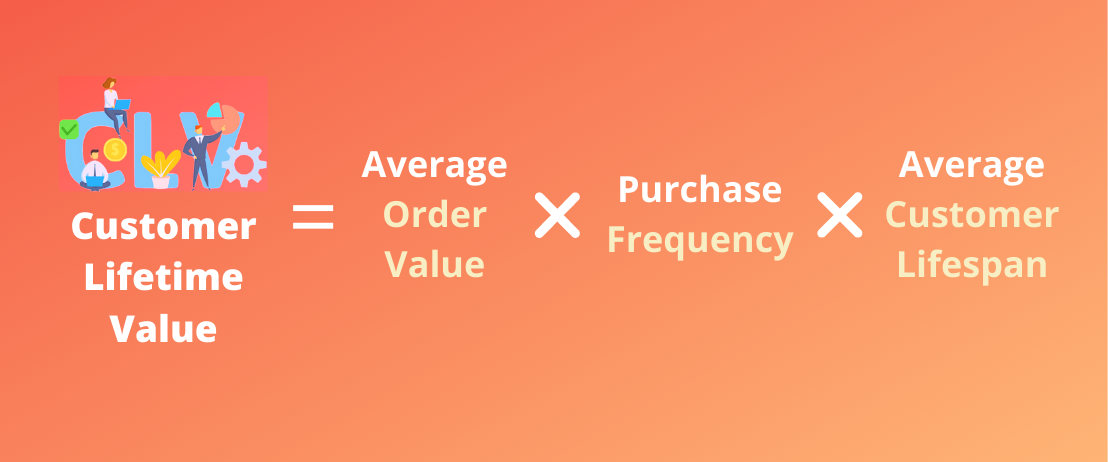
Measuring CLV for different customers will benefit your decision-making. It can indicate who your most profitable types of customers are, or which products have the highest profitability.
Knowing exactly which prospects to focus on will boost your sales productivity.
There are many more sales KPIs that you can collect to monitor your sales performance, but you should always focus on the ones that are relevant to your sales process.
9. Provide Continuous Training for Continued Success
Now you know how to monitor the performance of your sales team — but that’s not the end.
It’s just the beginning.
Salespeople will forget 80-90% of what they learned in training within a month, according to Sales Alliance. To make sure your team’s productivity is always at its peak, you need to provide continuous training.
Some top training strategies include:
- Align their roles with your sales goals, strategies, and needs
Your reps should have a clear view of the role they play in the team’s sales strategy and goals. You can create a chart that links their responsibilities to your common goals.
- Adopt learning through leaders
Salespeople grow faster when they are surrounded by top performers. They can learn skills like self-direction, problem-solving, and people skills.
- Keep up with industry trends
The sales world is constantly changing, and so should your sales team’s strategies. By staying on top of industry trends and news, your team will be better equipped to get the job done.
Every sales team is different, so make sure you customize your training based on your reps’ unique characteristics.
Training must be an ongoing process to adapt to the constant evolution of the sales industry.
5 Tips for Salespeople to Increase Sales Productivity
1. Develop A Winning Mentality
In sports, the highest-performing athletes are not necessarily those with the best skills, but who also have a winning mentality.
No coach can create the winning mentality just by demanding it from players. It has to come from within.
This applies to sales too.
Recent McKinsey data revealed that employees who are intrinsically motivated are more committed to their job, have a 46% higher job satisfaction, and perform 16% better than others.
But what is intrinsic motivation?
Neuroscience found that intrinsic motivation is inherent, as it drives the direction of an individual’s behavior and self-determination.
- When you are satisfied by the fact of performing a task, you are intrinsically motivated.
- If you perform the task just to earn money, you are extrinsically motivated.
In general, what motivates a salesperson the most is helping customers solve a problem. This motivation is largely guided by curiosity and creativity.

A natural curiosity drives salespeople to ask the right questions. The answers to those questions help them map the solution to their prospect’s needs.
If you’re not naturally curious, no pressure. You can ask yourself a few questions before every sales meeting:
- Who – Who will you talk to? Who are the decision-makers?
- What – What are their objectives and challenges?
- Why – Why do they need your solution?
- How – How can you help them? How will you convey your message?
Also, never underestimate your creativity.
What makes selling interesting is that you can’t sell a solution to every prospect the same way. That means you constantly need to come up with a new approach to highlight the value of your product. By regarding selling as a creative and non-repetitive task, you will get intrinsically motivated.
When you are genuinely interested in solving problems for your prospects and customers, you’ve got a winning mentality in sales.
2. Achieve Your Goals Faster with Sales Efficiency Tools
Speaking of winning mentality, something that winners do is working smart, not hard.
In sales, that means using cutting-edge sales tools to increase sales productivity.
Top-performing salespeople use technology to their advantage — to focus on selling instead of spending time doing busy work.
Digital calendars and appointment setting tools are designed to optimize your daily schedule and coordinate it with your prospects. Google Calendar and Outlook Calendar are industry favorites, while Calendly allows prospects to schedule meetings for time slots that work best for them.
For outside sales reps, there’s no better time-saver than route planner apps.
Badger Maps is the best example of such a tool — this app helps you find the best sales routes and streamline every aspect of your job, from territory mapping to lead generation.

Boost your sales productivity with the best field sales app:
3. Generate High-Quality Leads
Research shows that 50% of salespeople’s time is wasted on unproductive prospecting.
It’s good to have a long list of leads that you can pitch to and gain as customers, but it’s better to have a shorter list of great leads who have a higher potential to purchase.
If you can select leads that are most suitable for your product, you’ll not only boost productivity but also benefit from a higher conversion rate.
To find high-quality leads, the best tool is LinkedIn.
According to Hubspot, LinkedIn is 277% more effective for lead generation than Facebook and Twitter.

(Source: Hubspot)
Why?
LinkedIn has highly active users, and it involves professionals with purchasing power:
- Over 60 million senior-level influencers
- More than 40 million decision-makers
With LinkedIn Sales Navigator, you can save contacts or organizations that may be in your pipeline. These leads will then be displayed in your Sales Navigator news feed.
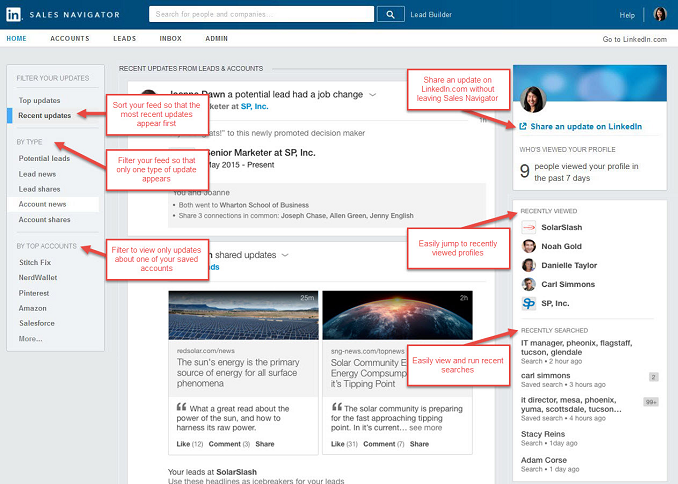
(Source: Brainshark)
Inmails, LinkedIn’s version of a direct message, enable you to communicate with leads even if they’re not your connections.
However, generating high-quality leads requires more efforts:
Post Targeted Content
Content is king, even on LinkedIn.
Check out which topics your prospects follow, then offer top-notch blog posts or webinars around those topics. It’s a great way to answer their questions and show your expertise, even before starting a conversation with them.
Remember that users who are not in your network can still follow you from your published content, so your next post will be seen by them.
Join LinkedIn Groups
LinkedIn Groups provide a place for professionals in the same industry or with similar interests to share their insights, ask for guidance, and build valuable connections.
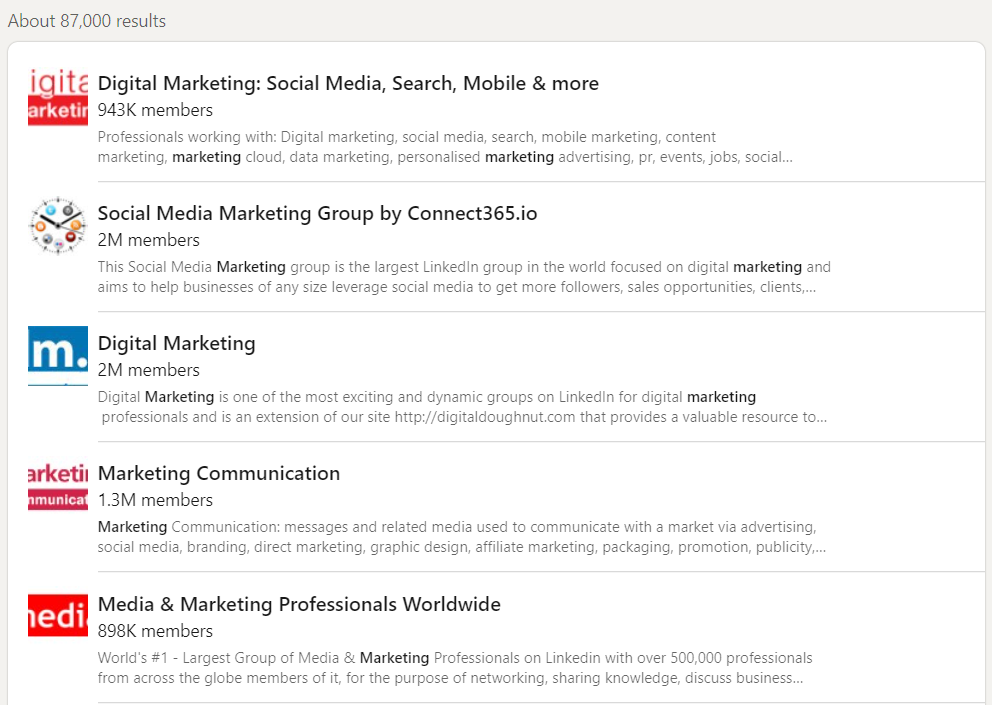
Joining a specific group helps you filter and qualify your target leads. More importantly, that’s where your conversation begins.
By focusing on the right leads, you’re working towards an increased CLV and, therefore, you’re increasing your productivity.
4. Master Time Management
If you did generate great leads, congratulations — 80% of sales come from 20% of clients.
But to be able to close those deals, you need more time spent on revenue-generating tasks.
Time blocking is an effective technique that frees up your busy schedule.
All you need to do is divide your day into blocks of time — each block is dedicated only to a specific task.
For example, spending a specific amount of time prospecting each day. Sending follow-up emails at the same time each day rather than checking your inbox all day long.
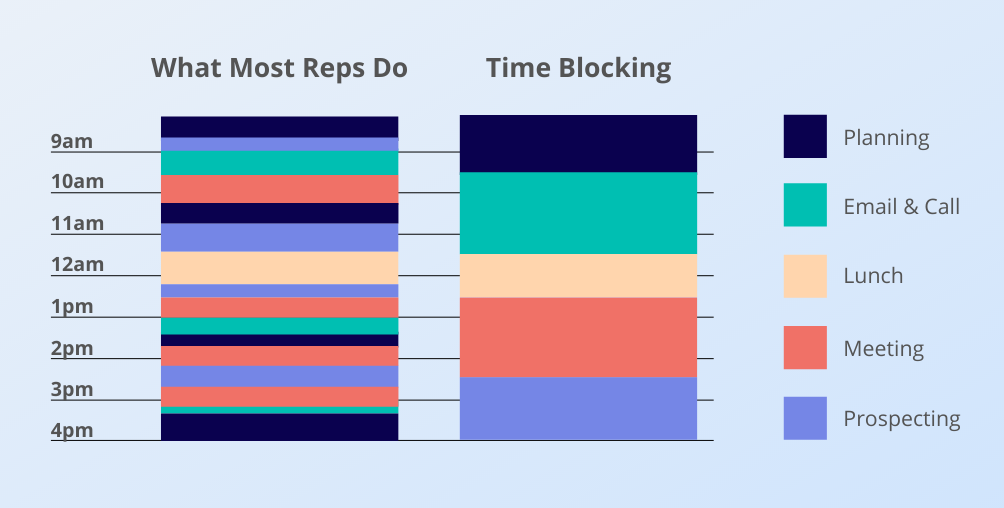
Grouping the same tasks together leads to higher productivity because when you focus on one activity at a time, you dedicate your full attention to that task and the amount of time it deserves.
To execute time blocking effectively, here’s your checklist:
- Plan your blocks at least one day ahead to start each day with a concrete schedule.
- Review any unfinished tasks at the end of the day.
- Preview any new tasks for tomorrow.
- Adjust your blocks based on the tasks.
- Follow your schedule.
When you plan your days in advance, you can save much time from constantly determining which task to focus on.
5. Create a Killer Sales Pitch
Salespeople spend about 1/3 of their day talking to prospects.
If you don’t know how to present your pitch effectively, most of that time is just wasted.
The best way to get action out of your prospect is to connect the dots between your product’s features, its benefits, and the business value that they can get.

So, what is the business value of that?
Ask the prospect: “What is your sales reps’ time really worth and how much more would your sales reps sell with two more meetings every single day?” If that business value is worth a lot more than your product, then half of your sales job is done.
By asking the right questions and getting actual numbers out of your prospect, you can show with their own numbers how much they stand to gain if they use your solution. That’s how you can move a deal forward.
How do you write a daily sales report?
Badger Maps is a powerful multi-stop route planner that provides all the tools that outside sales teams need to be successful.
Sales reps using Badger Maps cut drive time by 25%, freeing up an average of 8 hours a week. Teams report an average of 10 additional meetings per week thanks to the extra time.
How?
1. Easily Manage Your Sales Territory
Badger Maps enables a visual representation of your territory that makes your management a whole lot easier.
Color Filters present prospects as colored pins on the map according to criteria set by you, whether it is by “the date last visited” or by “the product you sold them”.
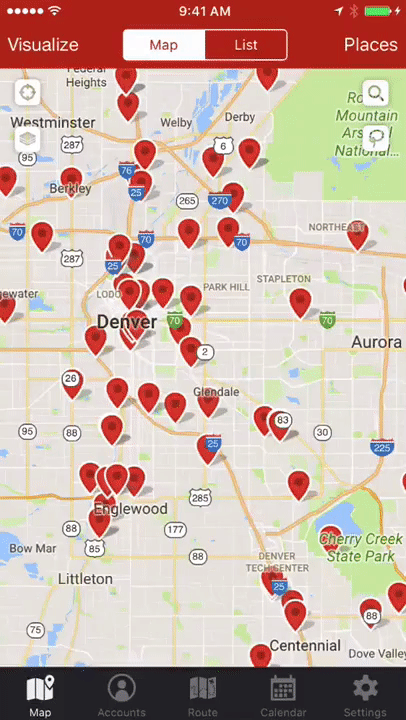
Having all the relevant data about your accounts at hand allows you to make strategic decisions on the go.
2. Find Optimal Sales Routes
The Routing feature analyzes real-time traffic and distances to give reps the most efficient route possible, and it provides turn-by-turn directions with your favorite GPS. To target specific prospects, users can either choose from their accounts or use the Lasso tool as shown below.
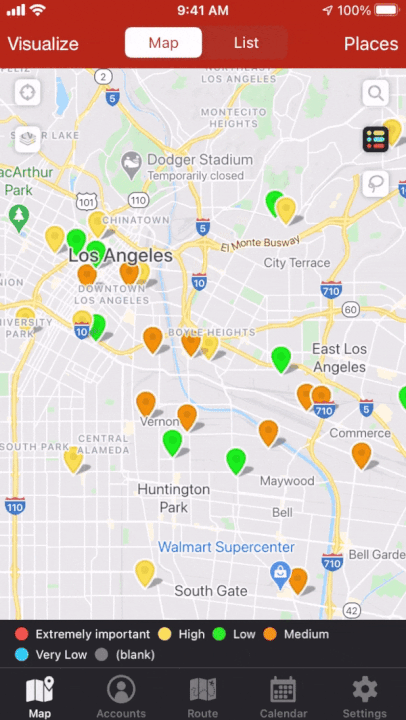
3. Prospect from Anywhere
The Places tool is designed to make your prospecting smarter. You can find new contacts on your map by keywords like industry, business name, and product type. This way, you can generate leads around your territory to add to your route.

4. Log Meeting Information Right from the Field
Check-ins are a great way to record meeting interactions right when they happen. These are time-stamped notes tied to every account you import into your Badger Maps account so you can keep track of what happened in every meeting.
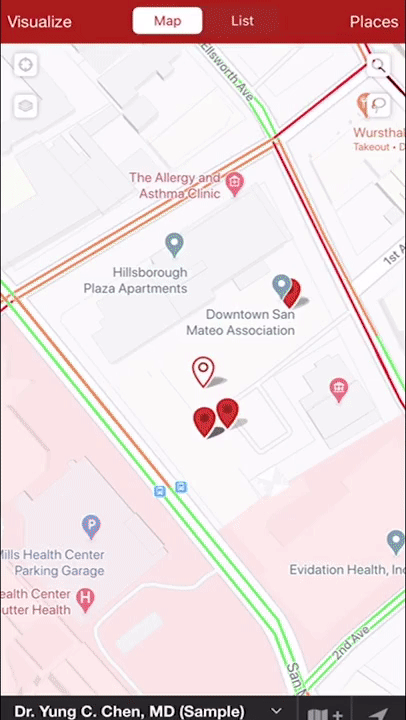
Badger’s custom check-ins provide a lot of flexibility and can be created based on your organization’s needs.
You can add customization to include the following field types: Log Type forms/Drop-Down menus, One-line text boxes, and Multi-line text boxes.
You’ll stay organized and productive by collecting the details you want from the field.

Pick the Right Info to Share
Once you identify the primary audience of your report, you next need to decide what data will give them an accurate picture of how your team is performing and help them make the decisions to keep their department or the entire company on track. Most reports, especially to upper management, should answer these key questions:
- Are you meeting your sales goals?
- What is your revenue versus expenses for the chosen time period?
- How did your team’s sales compare to previous periods (ex: previous quarter, previous year)?
- Which products and services are selling the most?
- Which products and services are not meeting expectations?
- What is your sales forecast for the next month/quarter/year?
- What are key areas for opportunities? Do you need to divide a territory or ask for executive assistance to close a big account?
- What are key challenges? Is it time to pull back from a territory or product line?
All of this information may not be necessary for every report you create, especially if you are presenting to a single department head who may only be interested in a narrow field of information. However, offering a more comprehensive picture of sales performance is often better than giving too little information.
How do Sales Reports Help Managers?
- Sales reports enable a manager to
- Track how much time salespeople are spending on different sales activities
- See if they are meeting their productivity goals
- Learn whether their efforts are translating into real sales
- Sales reports paint a picture of the sales representatives’ day even when the manager can’t be there to observe them
- The information in these reports plays a critical part in helping a manager oversee the success of the sales team and essentially the whole company

3. Decide on a Time Period
Are you going to share all your sales numbers from the inception of your company? That would be a pretty hefty report. Instead, figure out what time period you want to focus on. Is this a weekly report, a monthly report, a quarterly report, or a year-end review? The length of time will help determine the focus of the report.
For example, a yearly report will allow you to review larger trends in your industry, customer buying habits, as well as the results of major marketing initiatives, new product roll-outs, and seasonal fluctuations. Choosing a specific time period will also allow you to perform more accurate period-to-period comparisons.
4. Choose the Right Visuals
In every mountain of data you can mine many important, actionable gems, but you can’t expect your management team to grab a pickaxe and start digging. The way you decide to convey information is just as important as the information itself. The primary function of a good sales report is to convey information in a way that is easily understandable, digestible, and actionable.
When you begin compiling numbers, ask yourself, “How can I showcase an important point in the best way possible?” A bar graph may do a better job of showing how much sales of your flagship product have increased over the last five years than simply putting the numbers into a table. Or, maybe a pie chart is the clearest way of showing how each product contributes to your overall sales numbers.
Visually crafting your data isn’t just about making your sales report look pretty. It’s about making the information engaging and easy to understand. Your management team doesn’t have time to sift for gems of info, so don’t make them.
5. Gather Your Data
You can’t build a solid sales report or act without reliable information. Regardless of the size of your company or your particular industry, you need a robust CRM system to capture, track, filter, and help you analyze all of this information before you can put it into your report. Make sure your CRM system has capabilities specifically designed to help you quickly and easily put together highly focused and compelling sales reports.
For example, use a dashboard template that automates the organization of your most important sales metrics, including a Sales Executive Dashboard. You should design and personalize your dashboard to create reports tailored for different department heads. Get an eagle-eye view of your team’s sales performance over time, or dig down into the nitty gritty.
Whether your CEO wants you to present a 10-minute year-to-date review of sales for a new investor, or your VP of marketing asks for a day-long dive into the details of the latest marketing campaign results, use your CRM to quickly and easily design the reports you need.
6. Cut Out the Fluff
When you adopt a robust CRM, you gain access to an unprecedented amount of information. It will be easy to review every aspect of your sales apparatus with a fine-toothed comb. These are powerful abilities for you, the sales manager, but your CEO probably doesn’t need to know how many calls each of your sales reps made yesterday.
It may be tempting to stuff your sales report with as much information as possible, but resist the urge to drown your bosses in the details. Your goal is to present the management team with a clear and concise report that gives them only the information they truly need to take action.
Recommendations for Basic Sales Reports for Managers
What are the most important sales reports?
- The Daily Call Report
- Accounts are not all created equal
- Some need to be called on more frequently than others
- After establishing the call frequency for all of the salespeople’s accounts, the data from this report confirms whether they are adhering to the schedule
- Number of calls made in a row
- Specific types of calls
- Absence of certain types of calls
- Excessive numbers of certain types of calls
- Average length of call time
- Accounts are not all created equal
- The Productivity Report
- Those managing salespeople need a reasonably accurate summary of how many and which type of calls they make
- The data often includes the number of
- Outbound calls
- Conversations
- Voice mails
- Emails
- Customer meetings
- Product demonstrations
- Proposals generated in a given day, week, or month
- The purpose of this report is to compare actual results against the benchmarks established for each activity
- When reviewing this report, Paling advises managers to ask:
- At which point in the sales cycle is the rep below/above productivity quota?
- In which areas is the rep consistently behind/ahead?
- Where the rep is below/above the productivity quota, how does it affect the next phase of the sales cycle?
- The Pipeline
- The pipeline report consists of all those prospects being actively pursued by a sales representative
- Separates them by their appropriate phase in the sales cycle
- This information allows managers to keep track of the total number of prospects the salesperson is working with at any given point
- Managers can tell how quickly a prospect progresses from one stage to the next or be aware when a prospect drops out altogether
- Paling offers these as examples of typical pipeline phases:
- Phase I—Decision-maker expresses interest in product or service
- Phase II—Salesperson meets with decision maker
- Phase III—Decision-maker participates in product demonstration
- Phase IV—Proposal submitted
- Phase V—Sale closed/sale lost
- The Sales Forecast
- The single most important document generated in most sales organizations
- Holds salespeople accountable for the deals they intend to close at the end of each month
- Determines which opportunities need executive attention
- Helps to estimate revenue
- Paves the way for post-sale product or service delivery
- The accuracy of this report strongly affects the entire organization
- The sales forecast shows only those prospects in the final stages of purchasing the product or service
- When looking at the sales forecast, ask:
- In which months (1, 2, or 3) is the rep typically above or below quota?
- Does revenue usually drop in any one month in particular?
- How many accounts drop out/get added from one month to the next?
- Does the rep have an easier/more difficult time achieving quota in one product line vs. another?
- The single most important document generated in most sales organizations
- The Long-Range Sales Forecast
- Typically, the long-range forecast keeps track of prospects planning to buy anywhere from four months to two years from the time of the initial contact with the sales representative
- Many of these long-range sales involve
- RFPs
- Intense competition
- The possible replacement of the prospect’s current provider
- Sales like these usually require executive involvement at some point
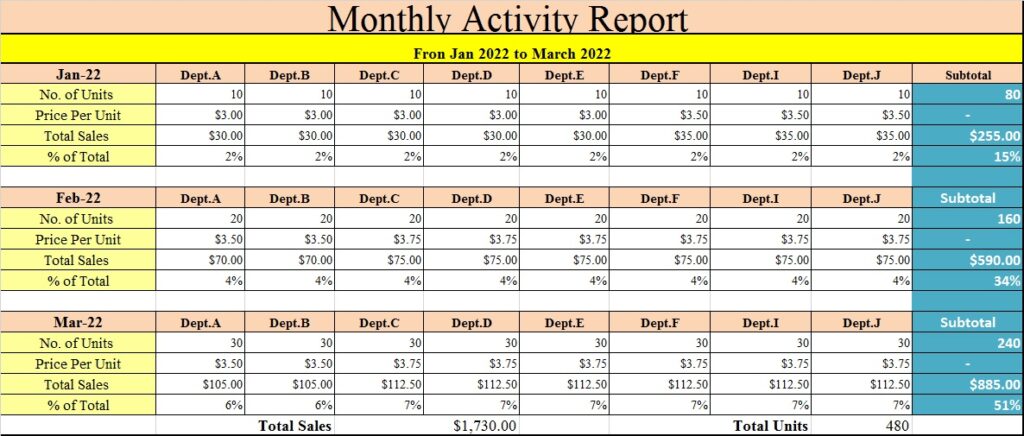
Tips to Help You Meet (and Beat) Your Retail Sales Targets
- Sales Analysis Report
- Sales Performance Report
- Daily and Monthly Sales activity report
- Annual Business Plan
- How to write a sales report to your Boss?
What are the benefits of daily sales report?

Track to Correct Sales Teams Key Result Areas on Daily Basis.
a) not meeting your retail sales targets; or
b) meeting your targets but want to find ways to blow past them.
Whatever the case, this post can help. We know how big of a deal sales are to retailers, so we’ve compiled a number of pointers to help you and your associates meet — and beat — your targets.
Check them out below.
Setting the right retail sales goals
Want to meet (or beat) your sales goals? Start by setting the right targets. There aren’t any hard and fast rules for doing this, as every company is different. Generally, though, you’ll want to consider the following factors when setting goals:
- Historical sales data
- Sales initiatives and events throughout the year
- The capacity of your sales team
- Employee input
1. Come up with sales targets that are challenging but achievable
Goal-setting can be tricky. On one hand, you need to set sales targets that are achievable but challenging at the same time. In other words, you don’t want to come up with goals that are too easy or too difficult to hit.
So, how do you find the right balance? Kevin Graff over at Graff Retail offers excellent advice. According to him, you need to apply the 70% rule to your sales goals.
“Goals should be achieved at least 70% of the time. If not, they’re too high and risk de-motivating your staff,” he wrote. “By the same token, if goals are achieved 90% or more of the time they’re too low and aren’t pushing your staff.”
2. Properly manage sales quota frequency and timeframes
When coming up with your sales targets, you’ll likely start with your annual revenue goal then break that down quarterly and then monthly. But when dealing with your sales team, you may want to set goals for shorter timeframes — think weekly or even daily.
Frequent sales quotas can give your associates continuous motivation. As the Harvard Business Review put it, “Under a monthly plan, salespeople who started off the month poorly might become less motivated after realizing they weren’t going to make their quota for that month — in essence giving up in the current month. Daily quotas would theoretically help prevent such behavior.”
To put that theory to the test, they conducted a study at a large Swedish retailer and compared sales results between stores that were given monthly versus daily quotas.
HBR found that having daily quotas increased sales productivity by nearly 5% and that the improvement was more pronounced for low-performing salespeople, with the bottom quartile experience an 18% boost in sales productivity.
What’s the reason behind this?
According to the publication, daily quotas seemed to help prevent those individuals from giving up for the rest of the month after having a slow start, which is typically the case for low performers.
That said, the study did find that while daily quotas increased sales volume, frequent quotas seemed to motivate salespeople to “to sell more quantities of low-ticket items, probably a result of shifting their mindset toward the smaller daily goals.”
This led to lower profitability because sales associates kept pushing the low-margin items.
If you experience this in your store, then try to find ways to incentivize employees to sell higher-ticket items. In other words, stick to frequent sales quotas, but look for creative ways to put your high-margin products front and center.
3. Clarifying your team’s targets makes it easier to achieve retail sales goals
A big goal-setting mistake people make is having vague targets. For example, simply saying that you want “increase sales” won’t cut it. In order to maximize your results, strive to set goals that are SMART — i.e., specific measurable, attainable, relevant, and time-based.
Sales goals examples include:
- Get 10 new customers to join your loyalty program every day.
- See a 20% increase in sales by the end of the month.
- Improve basket size by 15% by end of the quarter.
How to communicate your sales targets or goals
You’ve set your targets. Perhaps you’ve even mentioned them to your staff. That’s a good start, but if you want to drive those goals forward, you need to communicate them clearly and constantly.
Here are some ways of doing just that:
4. Talk up your goals throughout the day
Talk up those sales targets. This isn’t just about mentioning it at the start of the day and then asking about sales when you’re about to close. You need to talk about sales goals and performance throughout the day to keep those targets top of mind.
Spend a few minutes at the start of each shift talking about the team’s goals and how they’re doing. This will keep them accountable and motivated to achieve their targets.
5. Make those sales targets visible
Display your sales goals and achievements in the back room. Put up a board dedicated to sales and make sure it’s updated.
Another idea? Make your sales goals visible on your POS system. Look into your point of sale solution and see if it lets you set sales targets. If it does, find out how to make those numbers visible to relevant employees.
In Vend, for example, the Home screen shows the targets for the user currently signed in. This can be a very useful tool for identifying top performing cashiers or sales reps, and for tracking goals for each team member.

Once the targets have been set, the user will be able to monitor their progress from the home screen. There will be a section called ‘Your Sales’, which will show a progress bar of the user’s sales target. There is also a graph which shows the user the history of sales made across the period they have specified.

Vend Tip
Are you a Vend retailer? You can use the software to set sales goals for each user, and then make those targets visible on their home screen.
And if you want even more visibility into your sales targets, see if your POS lets you access key metrics on the go. Vend, for instance has Vend Reporter — a mobile app that lets you monitor all your retail data right from your iPhone.
You’ll have instant access to your dashboard, and there’s no need to open a browser or sign in to Vend every time. It also comes with an iOS14 widget that you can save to your homescreen. This means that all the important info about your business is literally just one swipe away.

Motivate your sales team to achieve retail sales goals
Putting those sales goals out there is a good step, but to really drive results, you need to keep your staff motivated. Here’s how to do just that.
6. Have your team share the store’s sales goals
Offering commission and giving bonuses are common — and recommended — motivation tactics for sales employees. Sometimes, though, certain commission structures can create unhealthy competition in which employees are only looking after their own interests rather than helping the store succeed as a whole.
In a recent Facebook Live video, Bob Phibbs shared an interesting method for preventing this.
He recommends setting a sales goal for your store, and then offering rewards to those who hit their quotas.
But here’s the thing: your staff will only be able to “unlock” their incentive if the overall store goal is met.
In other words, even if an employee achieves their own target, they won’t get a bonus if the store’s target sales aren’t met.
7. Competition among Team Members
Another great motivational tool? Games. According to Cara Wood, a former retail sales associate, regular contests did wonders for the performance of their sales teams.
“Running contests to encourage harder work was actually something the retailer I worked for was very good at. They regularly ran all kinds of contests, with excellent results from their teams,” she shared.
Some ideas? Check out the following:
Offer gift cards for opening store credit cards
Give out prizes the whole store can enjoy – Want to motivate an entire store? Consider a shared reward that everyone in the shop can enjoy if they outperform other locations.
Use games to encourage certain types of behavior – Running contests to encourage certain behaviors could also work. One idea comes from Ray Riley, CEO at People in Progress Global.
Use Lottery – Put an attractive price up for grabs to employees. Here’s where it gets interesting: your associates can earn their entries by making sales or hitting certain targets. So, the more they sell the better their chances of winning.
Invest in employee training
Are your employees still not meeting their sales targets despite constant reminders and motivation? Perhaps you need to invest more in training. When it comes to effective retail selling, you need to teach your staff what to sell and how to sell it.
(It sounds obvious, but so many retailers fail to invest in proper employee training.)
Don’t just put them on the floor with minimal knowledge and expect results. Put in the time and effort to educate them.
Some suggestions:
8. Make sure employees know the store’s products inside and out
First, teach them what to sell. Talk to them about each product and make sure they know the key features and benefits of every item.
Having a well-informed sales team is absolutely essential for the sales experience and actually driving more sales. The aesthetics of a particular product is very important, but people will always want to know what something’s made of, or a little bit about the designer.
Whenever new prodct arrives at the store, we sit down with the product in front of us, look at it really thoroughly, talk about the materials that it’s made from, what the is, what’s particularly unique about this product, and how to demonstrate it.
9. Train employees in the art (and science) of sales
Retail selling is a broad topic and there’s a whole range of things to tackle here. So rather than cramming all the info in this post, we thought we’d point you in the direction.
Build a store that’s conducive to increased retail sales
Finally, if you want your team to achieve the store’s sales goals, you have to ensure that your shop sets them up for success. Here’s how:
10. Drive ample foot traffic
It’ll be difficult to meet sales goals if there aren’t any customers to sell to. See to it that your store has a steady flow of traffic that your associates can convert. You can accomplish this by sprucing up your window displays, holding events, running promotions, and more.
Tail Piece:
In sales, the pursuit of productivity is never-ending. If you can streamline your sales process by:
- Setting better goals
- Embracing the right tools
- Qualifying your leads
- Monitoring your performance
- Mastering time management
Then you’ll be able to increase sales with less effort.
Sales is a marathon, not a sprint. The above sales tips should help you understand that every change you make today will pay off in the near future.



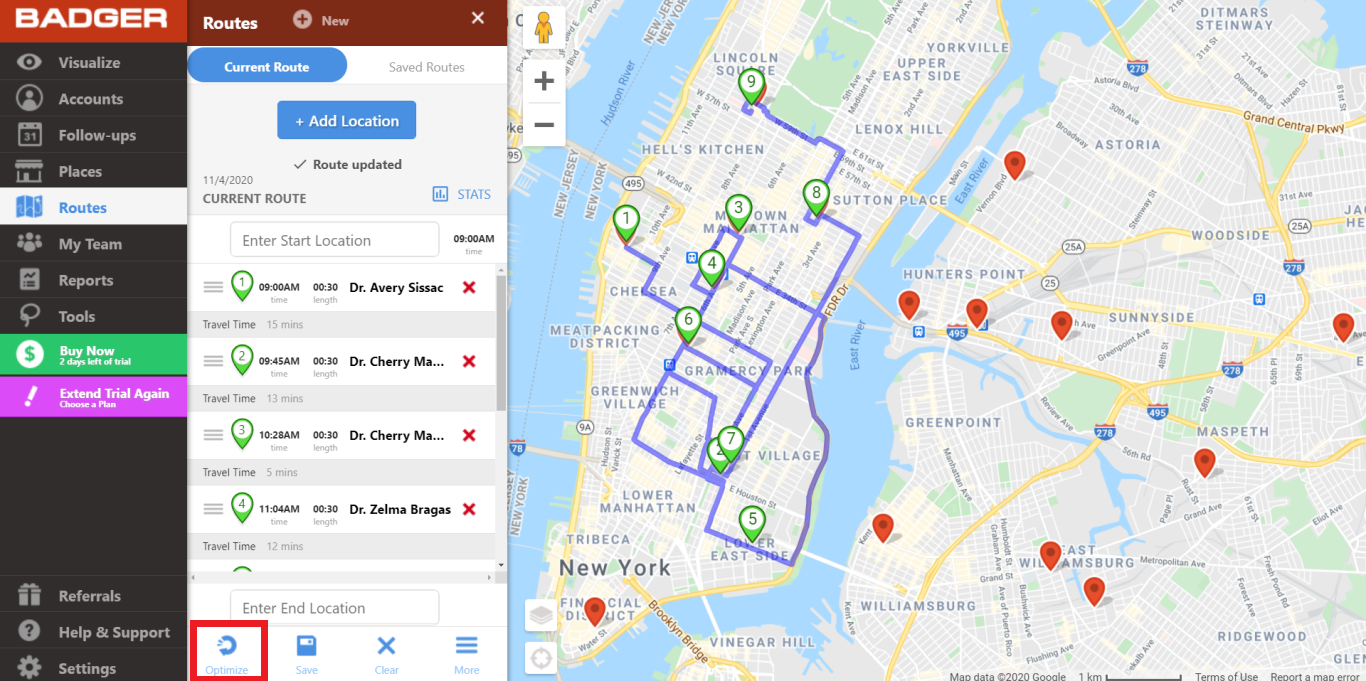




Pingback: Fmcg salesmen career growth with the right selling skills